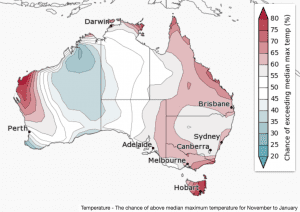The Bureau of Meteorology’s latest three monthly rainfall outlook released this morning suggests that areas eastern Australia may be in for a drier than average start to summer.
November to January rainfall is likely to be above average across large parts of WA.
Conversely, rainfall may be below average in some areas of southeast Queensland.
The month of November is likely to be drier across southern mainland Australia, but wetter across northwest Australia, the outlook suggests.
November to January rainfall is likely to be above average across most of WA, except the southwest.
A small area of southeast Queensland is slightly more likely to be drier than average.
For other areas, the chances of a wetter or drier three months are roughly equal.
The current outlook reflects a weakening negative Indian Ocean Dipole and an ENSO-neutral tropical Pacific. For November, a strong climate influence is likely to be a shift north in the position of westerly winds (the “Southern Annular Mode”) that affect southern Australia.
Historical outlook accuracy for November to January is moderate to high over eastern and western parts of Australia, and parts of the Top End of the NT.
Across central Australia, extending from eastern WA to western Queensland and much of SA, accuracy is low.
Warmer season likely for parts of the east
November to January days are likely to be warmer than average for parts of eastern Australia and far western WA. Days are likely to be cooler than average in eastern WA.
Night-time temperatures are also more likely to be warmer across eastern Australia and far western WA, with nights more likely to be cooler than average for southern WA.
The current outlook reflects a weakening negative Indian Ocean Dipole, an ENSO-neutral tropical Pacific, and warm ocean temperatures around Australia’s northern and eastern coastlines.
Maximum temperature accuracy is moderate to high over most of Australia, except to the south of the Gulf of Carpentaria, where accuracy is low. Minimum temperature accuracy is moderate to high over much of the country.
Source: Bureau of Meteorology






HAVE YOUR SAY